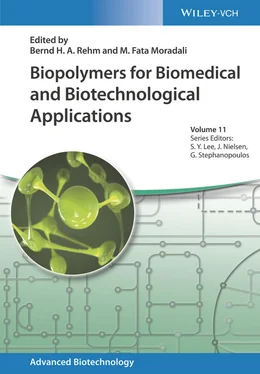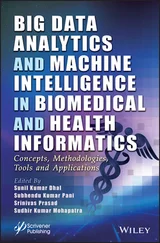Biopolymers for Biomedical and Biotechnological Applications
Здесь есть возможность читать онлайн «Biopolymers for Biomedical and Biotechnological Applications» — ознакомительный отрывок электронной книги совершенно бесплатно, а после прочтения отрывка купить полную версию. В некоторых случаях можно слушать аудио, скачать через торрент в формате fb2 и присутствует краткое содержание. Жанр: unrecognised, на английском языке. Описание произведения, (предисловие) а так же отзывы посетителей доступны на портале библиотеки ЛибКат.
- Название:Biopolymers for Biomedical and Biotechnological Applications
- Автор:
- Жанр:
- Год:неизвестен
- ISBN:нет данных
- Рейтинг книги:5 / 5. Голосов: 1
-
Избранное:Добавить в избранное
- Отзывы:
-
Ваша оценка:
- 100
- 1
- 2
- 3
- 4
- 5
Biopolymers for Biomedical and Biotechnological Applications: краткое содержание, описание и аннотация
Предлагаем к чтению аннотацию, описание, краткое содержание или предисловие (зависит от того, что написал сам автор книги «Biopolymers for Biomedical and Biotechnological Applications»). Если вы не нашли необходимую информацию о книге — напишите в комментариях, мы постараемся отыскать её.
Biopolymers for Biomedical and Biotechnological Applications — читать онлайн ознакомительный отрывок
Ниже представлен текст книги, разбитый по страницам. Система сохранения места последней прочитанной страницы, позволяет с удобством читать онлайн бесплатно книгу «Biopolymers for Biomedical and Biotechnological Applications», без необходимости каждый раз заново искать на чём Вы остановились. Поставьте закладку, и сможете в любой момент перейти на страницу, на которой закончили чтение.
Интервал:
Закладка:
There are few studies where the glycosidic bonds and polysaccharide structure were evaluated. Examples include (i) spirulan, the polysaccharide produced by A. platensis , which is composed of two disaccharide repeating units (→3)‐α‐L‐Rha‐(1→2)‐α‐L‐Aco‐(1→, where Aco (acofriose) was a sulfated 3‐ O ‐methyl‐Rha, and O ‐hexuronosyl‐Rha (aldobiuronic acid) [185]), and (ii) nostoflan, a polysaccharide from Nostoc flagelliforme composed of →4)‐β‐D‐Glc‐(1→4)‐D‐Xyl‐(1 and →4)‐[β‐D‐GlcA‐(1→6)‐]‐β‐D‐Glc‐(1→4)‐D‐Gal‐(1→ [66].
It should be noted that the chemical composition, type of linkage, sulfate content, and position might be significantly different depending on the species, the cultivation and extraction conditions, and the analytical methods employed [182,183,186,187]. As so, their biological activity can be significantly different. For example, the molecular weight of the EPS produced by Porphyridium cruentum influenced the immunomodulatory activity, with the polymer with lower molecular weight (Mw) having the strongest immunoenhancing effect [188].
2.6.2 Biological Activity and Potential Applications
Due to the structural and chemical diversity of microalgal EPS, they have been the subject of recent research on their biological activity and potential application in the fields of biomedicine, pharmaceuticals, cosmeceuticals, and therapeutics [189]. Reported bioactive properties are presented in Table 2.3and include anti‐inflammatory, immunomodulatory, antioxidant, antiviral, antibacterial, antitumor, and antihyperlipidemic activity, as well as anticoagulant and/or antithrombotic properties [183,184,189,190].
2.6.2.1 Antiviral Activity
Generally, polysaccharides rich in sulfate groups have antiviral capacity. These molecules seemed to be able to block the binding of the virions to the host cell surfaces [77,183,191] and inhibit reverse transcriptase in human immunodeficiency virus (HIV), interfering with the replication and the production of new viral particles [183,191,192]. For example, sulfur‐containing EPS from Arthrospira presented antiviral activity against numerous viruses, including human cytomegalovirus (HCMV), antihuman immunodeficiency virus (anti‐HIV), herpes simplex virus type 1 (HSV‐1), human herpes virus type 6 (HHV‐6), measles virus, mumps virus, influenza A virus, ectromelia virus (ECTV), and vaccinia virus (VACV) [42]. P. cruentum secreted an EPS that had a higher antiviral activity against vesicular stomatitis virus than the chemical compounds ribavirin, brivudine, cidofovir, and ganciclovir [45]. Naviculan, a sulfated polysaccharide from diatom Navicula directa , inhibited enveloped viruses HSV‐1, HSV‐2, and influenza A. This polysaccharide inhibited host cell binding and virus penetration and had an inhibitory effect on cell–cell fusion between CD4‐expressing and HIV virus gp160‐expressing cells that were used as a model of HIV infection [77]. The antiviral activity of the polysaccharides produced by red microalgae was related to their anticancer properties, as these sulfated polysaccharides were able to inhibit murine leukemia retrovirus and cell transformation by murine sarcoma virus by interfering with early steps of replication, virus absorption into the host cells, and after provirus integration into the host genome [193]. Moreover, the sEPS from Gyrodinium impudicum inhibited or slowed the effect of encephalomyocarditis virus in infected HeLa cells, without any cytotoxic effects to the host cells [52]. The antiviral efficiency is also related to the molecule size, content in sulfate, monosaccharide composition, and linkage diversity [191].
2.6.2.2 Immunomodulatory, Anti‐inflammatory, and Anticancer Activities
The immune system comprises immune organs, immune cells, and immune substances and is the most important system in pathogen defense and tumor control [194]. Microalgal polysaccharides with immunomodulatory activity (Table 2.3) were able to promote macrophages response; induce mature dendritic cells (DCs); affect the functions of B cells, T cells, and NK cells; and interfere with migration and adhesion of leukocytes. Antitumor activity of microalgal EPS has been evaluated in vitro with cancer cell lines or in vivo using animal models. Anticancer activity can be direct via inducing apoptosis of cancer cells (i.e. depolarization of mitochondrial membrane) or cell cycle arrest and/or prevent metastasis or indirect by enhancing the innate immune system that leads to anticancer efficiency (i.e. nitric oxide [NO] pathway) [194,195]. Khan et al. [195] have reviewed the mechanisms behind polysaccharide's anticancer potential.
Stimulation of Macrophage Response
Several studies report that microalgal EPS can led to the activation of macrophages. Macrophage activation is achieved by (i) improving macrophage proliferation, (ii) enhancing phagocytic activity, (iii) increasing NO and reactive oxygen species (ROS) production, and (iv) stimulating or regulating cytokines and chemokines release [188]. In vitro , EPS produced by P. cruentum promoted the proliferation of peritoneal macrophages and increased the NO production. Furthermore, the EPS enhanced lymphocyte proliferation in tumor‐bearing mice, which suggests that the mechanism for the antitumor activity against implanted S180 tumor might be related to the immunomodulatory activity of this polysaccharide [188]. Sulfated EPS produced by the harmful G. impudicum induced the activation of murine peritoneal macrophages that had a cytotoxic effect on tumor cells, which was mainly due to the production of NO [51]. The EPS from D. chlorelloides exhibit a significant immunomodulatory effect by stimulation of anti‐ and pro‐inflammatory cytokines [71].
Effect of Polysaccharides in T, B, D, and NK Cells
DCs are the most efficient cells in delivering antigens to T cells and expressing several co‐stimulatory molecules that led to their activation. When activated, T cells are target specific and highly efficient in tumor treatment [194]. PCEPS, an EPS produced by Parachlorella kessleri , inhibited cell growth of both murine and human colon carcinoma cells. Moreover, PCEPS stimulated the growth of splenocytes and bone marrow cells, increasing specific subpopulations of the cells, namely, CD19 +B cells, 33D1 +DCs and CD68 +macrophages, and CD8 +cytotoxic T cells. In a murine colon carcinoma peritoneal dissemination model with syngeneic mice, the polysaccharide attenuated tumor growth. These results suggest that PCEPS has both direct and indirect tumoricidal activity, respectively, via inhibiting cell growth and stimulating the host immune responses [76].
Antiproliferative and Direct Anticancer Potential
Other microalgal EPS have shown direct antitumor and antiproliferative effect. Gymnodinium sp. EPS (GA3) promoted the apoptosis of human myeloid leukemia K562 cells by the inhibition of topoisomerases I and II [50]. Calcium spirulan of Arthrospira was reported to prevent pulmonary metastasis by inhibiting adhesion and proliferation of tumor cells [196]. EPSAH, an EPS produced by Aphanothece halophytica , induced apoptosis on the HeLa human cervical cancer cell line by targeting the protein regulator Grp78 that induces the loss of mitochondrial membrane potential and the p53–survivin pathway, resulting in caspase‐3 activation and causing apoptosis [55].
Anti‐inflammatory Activity
EPS produced by microalgae species such as Porphyridium , Cyanobacterium aponinum , Phaeodactylum tricornutum , and Chlorella stigmatophora have been reported to have anti‐inflammatory properties associated with their immunomodulatory activity. Both polysaccharides from P. tricornutum and C. stigmatophora had anti‐inflammatory activity in the carrageenan‐induced paw edema test. P. tricornutum enhanced phagocytic activity both in vitro and in vivo , while C. stigmatophora showed immunosuppressant effects [69]. Sulfated polysaccharides from red microalgae Porphyridium inhibited the migration and adhesion of polymorphonuclear leukocytes in vitro , which seems to be related to the in vivo anti‐inflammatory effect of the polysaccharide that also inhibited cutaneous erythema in human subjects, as leukocyte migration to the site of injury contributes to the production of NO and cytokine release, resulting in the inhibition of over‐inflammation [39]. Furthermore, EPS from C. aponinum , a cyanobacteria from Blue Lagoon ecosystem (Iceland), affected human DC maturation in vitro , leading to the secretion of immunosuppressive cytokine IL‐10 and consequent stimulation of T‐cell differentiation with a decreased Th17 but increased Treg phenotype. These results suggested that EPS from C. aponinum might be related to the beneficial effects on psoriasis observed in patients bathing in the Blue Lagoon [70].
Читать дальшеИнтервал:
Закладка:
Похожие книги на «Biopolymers for Biomedical and Biotechnological Applications»
Представляем Вашему вниманию похожие книги на «Biopolymers for Biomedical and Biotechnological Applications» списком для выбора. Мы отобрали схожую по названию и смыслу литературу в надежде предоставить читателям больше вариантов отыскать новые, интересные, ещё непрочитанные произведения.
Обсуждение, отзывы о книге «Biopolymers for Biomedical and Biotechnological Applications» и просто собственные мнения читателей. Оставьте ваши комментарии, напишите, что Вы думаете о произведении, его смысле или главных героях. Укажите что конкретно понравилось, а что нет, и почему Вы так считаете.












